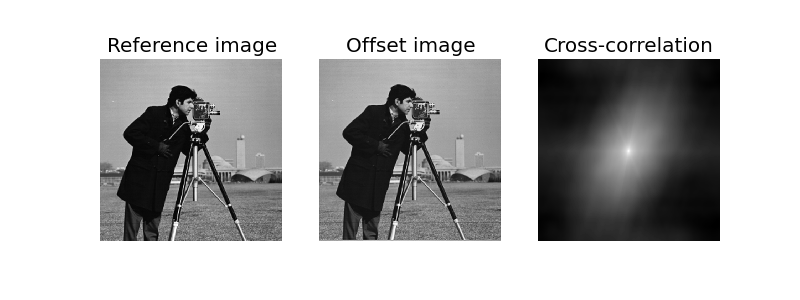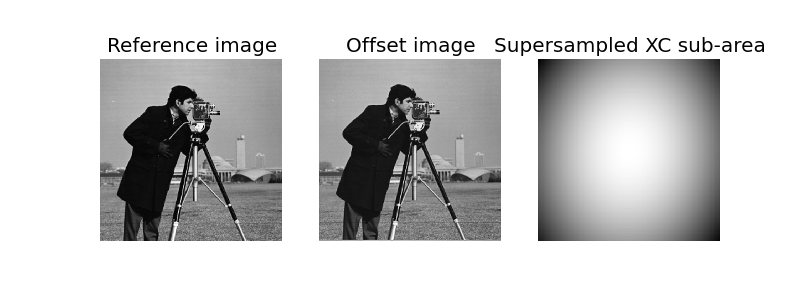
In this example, we use phase correlation to identify the relative shift between two similar-sized images.
The register_translation function uses cross-correlation in Fourier space,
optionally employing an upsampled matrix-multiplication DFT to achieve
arbitrary subpixel precision. [1]
| [1] | Manuel Guizar-Sicairos, Samuel T. Thurman, and James R. Fienup, “Efficient subpixel image registration algorithms,” Optics Letters 33, 156-158 (2008). |


import numpy as np
import matplotlib.pyplot as plt
from skimage import data
from skimage.feature import register_translation
from skimage.feature.register_translation import _upsampled_dft
from scipy.ndimage import fourier_shift
image = data.camera()
shift = (-2.4, 1.32)
# (-2.4, 1.32) pixel offset relative to reference coin
offset_image = fourier_shift(np.fft.fftn(image), shift)
offset_image = np.fft.ifftn(offset_image)
print("Known offset (y, x):")
print(shift)
# pixel precision first
shift, error, diffphase = register_translation(image, offset_image)
fig = plt.figure(figsize=(8, 3))
ax1 = plt.subplot(1, 3, 1, adjustable='box-forced')
ax2 = plt.subplot(1, 3, 2, sharex=ax1, sharey=ax1, adjustable='box-forced')
ax3 = plt.subplot(1, 3, 3)
ax1.imshow(image)
ax1.set_axis_off()
ax1.set_title('Reference image')
ax2.imshow(offset_image.real)
ax2.set_axis_off()
ax2.set_title('Offset image')
# View the output of a cross-correlation to show what the algorithm is
# doing behind the scenes
image_product = np.fft.fft2(image) * np.fft.fft2(offset_image).conj()
cc_image = np.fft.fftshift(np.fft.ifft2(image_product))
ax3.imshow(cc_image.real)
ax3.set_axis_off()
ax3.set_title("Cross-correlation")
plt.show()
print("Detected pixel offset (y, x):")
print(shift)
# subpixel precision
shift, error, diffphase = register_translation(image, offset_image, 100)
fig = plt.figure(figsize=(8, 3))
ax1 = plt.subplot(1, 3, 1, adjustable='box-forced')
ax2 = plt.subplot(1, 3, 2, sharex=ax1, sharey=ax1, adjustable='box-forced')
ax3 = plt.subplot(1, 3, 3)
ax1.imshow(image)
ax1.set_axis_off()
ax1.set_title('Reference image')
ax2.imshow(offset_image.real)
ax2.set_axis_off()
ax2.set_title('Offset image')
# Calculate the upsampled DFT, again to show what the algorithm is doing
# behind the scenes. Constants correspond to calculated values in routine.
# See source code for details.
cc_image = _upsampled_dft(image_product, 150, 100, (shift*100)+75).conj()
ax3.imshow(cc_image.real)
ax3.set_axis_off()
ax3.set_title("Supersampled XC sub-area")
plt.show()
print("Detected subpixel offset (y, x):")
print(shift)
Python source code: download
(generated using skimage 0.12.3)
IPython Notebook: download
(generated using skimage 0.12.3)